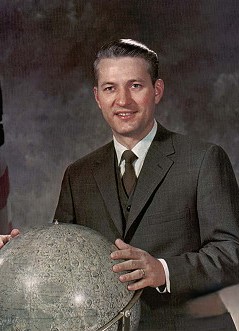On Aug. 14, 1969, NASA announced the selection of seven new astronauts. The Group 7 astronauts consisted of pilots transferred from the Manned Orbital Laboratory (MOL) Program canceled two months earlier. The MOL, a joint project of the U.S. Air Force (USAF) and the National Reconnaissance Office, sought to obtain high-resolution photographic imagery of America's Cold War adversaries. The Air Force selected 17 pilots in three groups for the MOL program - eight pilots in 1965, five in 1966, and four in 1967. After the cancellation, NASA invited the younger (under 35) of the 14 remaining MOL pilots to join its astronaut corps at the Manned Spacecraft Center, now the Johnson Space Center in Houston. The selected pilots included Major Karol J. "Bo" Bobko, USAF, Commander Robert L. Crippen, US Navy, Major C. Gordon Fullerton, USAF, Major Henry W. "Hank" Hartsfield, USAF, Major Robert F. Overmyer, US Marine Corps, Major Donald H. Peterson, USAF, and Commander Richard H. Truly, US Navy. In addition to the seven selected as astronauts, NASA assigned an eighth MOL pilot, Lt. Colonel Albert H. Crews, USAF, to MSC's Flight Crew Operations Directorate. Prior to his MOL training, Crews served as a pilot for the X-20 Dyna-Soar Program, an early USAF experimental lifting body vehicle canceled in 1963.


Left: Official NASA photograph of Group 7 astronauts Karol J. "Bo" Bobko, left, C. Gordon Fullerton, Henry "Hank" W. Hartsfield, Robert L. Crippen, Donald H. Peterson, Richard H. Truly, and Robert F. Overmyer who transferred from the Manned Orbiting Laboratory program. Right: Official Air Force portrait of Albert H. Crews. Image credit: courtesy U.S. Air Force.
The MOL Program had envisioned a series of 60-foot-long space stations in low polar Earth orbit, occupied by 2-man crews for 30 days at a time, launching and returning to Earth aboard modified Gemini-B capsules. Externally similar to NASA's Gemini spacecraft, the MOL version's major modification involved a hatch cut into the heat shield that allowed the pilots to access the laboratory located behind the spacecraft without the need for a spacewalk. While MOL pilots would carry out a variety of experiments, a telescope with imaging systems for military reconnaissance constituted the primary payload intended to fly in the laboratory. The imaging system carried the Keyhole KH-10 designation with the code name Dorian. Its 72-inch primary mirror could provide high resolution images of targets of military interest. To reach their polar orbits, MOLs would launch from Vandenberg Air Force, now Space Force, Base in California atop Titan-IIIM rockets. Construction of Space Launch Complex-6 (SLC-6) had begun in 1966 to accommodate that launch vehicle but stopped with the program's cancellation. When NASA and the Air Force decided to fly payloads into polar orbit using the space shuttle, in 1979 they began to reconfigure the SLC-6 facilities to accommodate the new vehicle. After the January 1986 Challenger accident, the agencies abandoned plans for shuttle missions from Vandenberg and mothballed SLC-6.




Group 7 astronauts. Left: Karol J. "Bo" Bobko. Middle left: Robert L. Crippen. Middle right: L. Gordon Fullerton. Right: Henry "Hank" W. Hartsfield.






